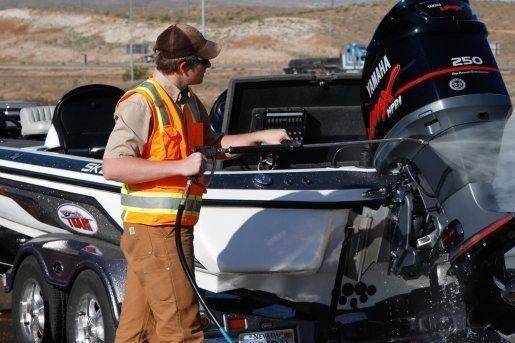A surprise was waiting for boaters who entered Utah from Arizona on the morning of May 13.
They were required to pull off of Interstate 15 at the port of entryВ just south of St. George. Then biologists and law enforcement officers with the Division of Wildlife Resources inspected their boats and personal watercraft for quagga mussels. The DWR and the Utah Department of Transportation joined forces to conduct the checkpoint.
(Currently, Lake Mead and the other reservoirs that are part of the Lower Colorado River system are infested with quagga mussels.)
During the six hours the checkpoint was held, DWR personnel inspected 20 boats and watercraft. Two of the boats had just left infested waters in Nevada and were decontaminated on the spot.
The decontamination was accomplished by giving each boat a high pressure wash with hot — 140 degrees — water.
DWR Lieutenant Scott Dalebout says the goal of the checkpoint was to keep Utah from becoming infested with what Dalebout calls “a very expensive pest.”
“Quagga mussels could cost Utah millions of dollars if they get a foothold here,” Dalebout says. “We intend to do everything in our power to see that does not happen.”
In May 2010, a single quagga mussel was found in Sand Hollow Reservoir southwest of Hurricane. Since May 2010, no additional mussels have been found in Sand Hollow or in any other water in Utah. “With the public’s assistance,” says Richard Hepworth, a regional DWR fisheries biologist, “we [can] make sure we don’t find anymore.”
Hepworth reminds boaters and anglers that any boat or watercraft that is placed on Sand Hollow Reservoir must be decontaminated before it can launched on another body of water.
High pressure washers are available at Sand Hollow and other waters in southern Utah. Boaters and anglers are encouraged to take advantage of this free service.
Why the concern?
Quagga mussels and their cousins — zebra mussels — are non-native, clam-like invasive species. They reproduce quickly and can over populate a body of water. Once they establish themselves in a lake or a reservoir, they can clog water lines and compete with fish for available food.
If you’ve boated on a water that’s considered infested with quagga or zebra mussels, you can’t launch your boat in Utah until it’s been decontaminated.
You can have the DWR decontaminate it for free, or you can follow a simple clean, drain and dry process. The simple process is explained at www.wildlife.utah.gov/dwr/decontaminate.html.
You can also see the three steps in a video at the DWR’s YouTube site– www.youtube.com/UDWR.
Once you arrive at www.youtube.com/UDWR, scroll through the video choices on the right side of the page until you find the video titled “Stop the spread of invasive mussels from Sand Hollow — clean, drain and dry your boat.”
Please remember that transporting live mussels within Utah or across Utah’s border into another state is against the law.

